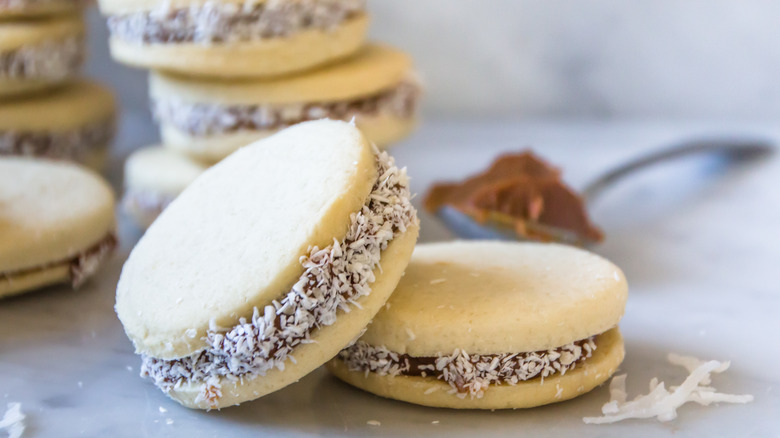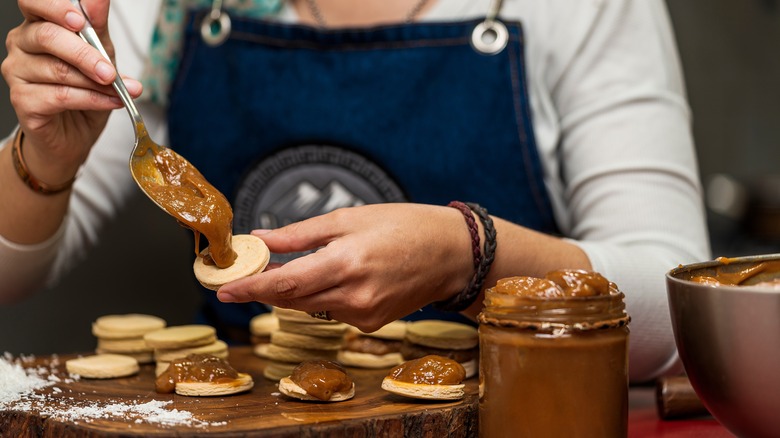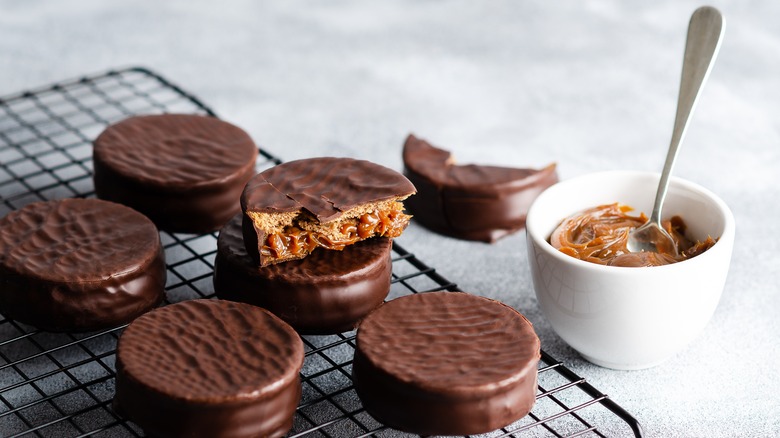Alfajores: The Sweet Shortbread Sandwich Cookies You Should Know
It's no secret that America has a love affair with cookies. According to the South Florida Reporter, Americans eat about 300 cookies per year or over 2 billion total as a country. Cookies act as midday treats, desserts, gifts, wedding favors, and so much more. There is a cookie, it seems, for every taste under the sun, whether that's the classic chocolate chip, the seasonal Girl Scout cookies, or festive gingerbread. But one cookie arguably out-cookies them all and it happens to be in the form of a sandwich cookie. Business Insider claims that the Oreo cookie is the world's most popular cookie.
Per Food Business News, in 1908 Hydrox cookies were introduced to America and became an instant hit. People loved the two chocolate cookies sandwiching vanilla cream invented by Jacob Loose. In 1912, Jacob's brother and business rival, Joseph, created a strikingly similar confection which he named Oreo. Initially, Hydrox was more popular, but eventually, Oreo took the lead and remained there.
Beyond Hydrox and Oreo cookies, sandwich cookies in general became an American staple and today it's rare to spot a cookie platter without some version on it, whether that's French macarons, Oatmeal Cream Pies, or Nutter Butters. Sandwich cookies certainly aren't exclusive to North America, in fact, one of the most delicious sandwich cookies you can find comes from way south of the border. If you haven't tried Alfajores, a South American specialty cookie, you're definitely missing out.
What are alfajores?
According to Masterclass, alfajores (pronounced alfa-hor-ez) are confections consisting of two round shortbread cookies with creamy dulce de leche filling inside. They are known to be popular in several South American countries and depending on where you find them, they may have extra flavorings. For example, in Argentina, the cookies are often rolled in shredded coconut, while a Peruvian alfajore might include honey or cinnamon. All in all, Serious Eats suggests the cookie should be tender and buttery and the filling sweet and creamy.
Although known for being South American, alfajores actually have a long history that began thousands of miles away. According to a blog from San Diego-based bakery Alfa Bakery which specializes in alfajores, the prototype of the cookie came from Middle Eastern Moors in the eighth century. Called "alaju," the confection incorporated dried fruit preserves surrounded by dough and rolled in sugar or nuts. When the Moors occupied Spain, they brought these cookies with them. Naturally, the Spaniards came up with their own version and christened them "alfajores." Masterclass agrees and explains that it wasn't until the Spanish came to South America in the 16th century that these cookies came to settle in the land they'd be most recognized from and began evolving into the familiar form alfajores take today.
How are alfajores made?
The New York Times explains that to make the cookies, sugar, and butter are beaten until fluffy and egg yolks are then mixed in. A mixture of brandy, vanilla, and lemon zest is incorporated into the batter. At this point, flour, cornstarch, baking powder, baking soda, and salt are added and everything is combined. The dough is split in half, rolled into logs, and chilled. The dough is then sliced into rounds and put into a preheated oven to bake until the edges of the cookies are golden. Once cooled, a healthy dollop of dulce de leche (store-bought or homemade) is sandwiched between a pair of shortbread cookies.
Alfajores can be dipped in chocolate, rolled in nuts, dusted with powdered sugar, or you can add your own personal touch to them. Alfajores may not be America's favorite sandwich cookie, but that's probably only because most people haven't tried them. They're sure to be memorable in your home.


